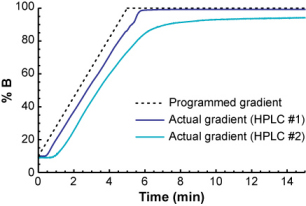|
Welcome to measureyourgradient.org! This site provides a fast and easy way to measure your HPLC gradient.
 The gradient profile actually produced by your HPLC instrument can be very different from the one you program it to produce. Unless the differences are properly measured and taken into account, they can cause run-to-run variation in your retention times and unexpected shifts in retention when transferring methods between HPLC instruments.
The gradient profile actually produced by your HPLC instrument can be very different from the one you program it to produce. Unless the differences are properly measured and taken into account, they can cause run-to-run variation in your retention times and unexpected shifts in retention when transferring methods between HPLC instruments.
Unfortunately, existing methods of measuring gradient profiles are cumbersome, they require an absorbance detector (mass spectrometers cannot be used), and they must be performed under experimental conditions that place unusual demands on the pump (e.g. both solvents are water, the HPLC column is removed, etc.).
This site provides a new way to measure your HPLC gradient. You simply run a solution of 20 standards (which may be purchased here) in a gradient and enter their retention times into the open-source Measure Your Gradient application. It automatically back-calculates what the gradient profile produced by your HPLC instrument must have been to give those retention times. If you are using LC-MS, it's even easier - you can simply load the LC-MS data file into the software and it will automatically extract the retention times of the standards and back-calculate your gradient profile.
This approach offers a number of advantages:
1) It is easy to use and fast. You simply run a test mixture containing 20 standards and report their retention times to the open-source Measure Your Gradient application. You can even have the software automatically extract the retention times from your LC-MS data file.
2) Since the gradient profiles are measured from the retention times of the standards, it doesn't matter what type of detector you use - a mass spectrometer works great.
3) There's no need to reconfigure your HPLC to measure the gradient profiles it produces. All you have to do is run the standard mixture in a gradient.
4) The gradient profiles are measured under precisely the same experimental conditions as your regular reversed-phase LC-MS runs. Therefore, the back-calculated gradient profiles more accurately reflect the one that analytes experience in your real HPLC runs.
See the step-by-step instructions to learn how you can measure your own gradient using this approach.
|
